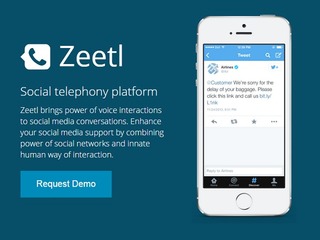

Social media represents a holy grail for brands and businesses. We are all sitting there, giving them our information on a silver platter. The problem is that there are now so many of them, from Facebook to Twitter to LinkedIn to Google+ to Ello to whatever the new one is going to be.
So, to keep track of all of their social network channels, many brands have turned to Hootsuite, a social media management system for businesses, allowing them to collaboratively execute campaigns across multiple social networks from a single, Web-based dashboard.
Businesses can launch marketing campaigns, identify and grow audience, and distribute targeted messages. Its customers include PepsiCo, Virgin, Orange, Sony Music, Telus, HBO, WWF, UPS, Panasonic, and 237 of the Fortune 500 companies.
The company makes its money by offering a tiered pricing system.
The first plan is free, and is recommended for personal use. It comes with the ability to monitor up to three social profiles, schedule one post to go up at a specific time, three basic analytics reports, access to monitor free apps, and the ability to create Facebook ads.
Having this type of freemium model has been key to Hootsuite’s success, Ryan Holmes, the company’s founder and CEO, wrote in an article for the Financial Post in April, calling it a “fundamental decision.”
“Why invest so many resources and so much bandwidth catering to millions of free users who would never account for a cent of revenue? For starters, freemium dramatically reduces the need for traditional marketing and sales efforts,” he wrote. “Our free users — in steady, predictable numbers — became paid users. Instead of having to sell them on the merits of our product with expensive ads, we let them see for themselves. Our product became our best marketing tool and salesperson.”
On average more than half of Hootsuit’e paying customers, including large clients, have started out as free users of the service before deciding to pay for it.
“Meanwhile, our free user base fulfilled another key function: It kept us honest. Free users are fickle; they’re not locked in by a contract or any other obligations. They can, at any moment, pick up and take their ‘business’ elsewhere. So to maintain and grow our free user base, we had to continually update our product, rolling out new features to stay ahead of the pack,” Holmes wrote.
The company offers two paid plans. The first is its Pro plan, which is good for business and costs $9.99 per month.
It comes with the ability to monitor up to 50 social profiles for free, as well as 10 more, up to fifty more in total, for $10 a month; the ability to schedule up to 350 posts to go up at a specific time; one team member authorized to use Hootsuite, with the ability to add eight more for $15 a month each; one enhanced analytics report and three basic; access to monitor free apps and exclusive premium apps; optional vanity URLs; 100 archived messages; enhanced technical support; and Hootsuite’s Security platform.
The second paid plan is its Enterprise plan, which is best for corporations, organizations and governments.
It has unlimited social profiles, message scheduling, team members, analytics reports, app integrations, and messaging archiving. It also comes with compliance integrations, Hootsuite campaigns, geo-targeting and a dedicate account representative.
Founded in 2008, Hootsuite is used by over 10 million people around the globe and over 800 of the Fortune 1000. It is used in over 175 countries and it offers its product in 16 languages, and 6 support languages.
It has over 1700 Enterprise customers, including Oakley, Levis, Siemens, Orange, Sony Music, Local World and others.
The company has raised $285 million in funding, from investors that include Fidelity Investments, Hearst Ventures, Blumberg Capital, Millennium Technology Value Partners, Geoff Entress, Accel Partners, Insight Venture Partners, OMERS Ventures and Silicon Valley Bank.
(Image source: avioncommunications.com)




















